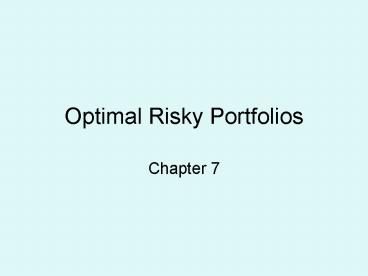Optimal Risky Portfolios - PowerPoint PPT Presentation
1 / 35
Title:
Optimal Risky Portfolios
Description:
Do the weights from mathematical formula agree with Excel solutions? ... Figure 7.7 The Opportunity Set of the Debt and Equity Funds with the Optimal CAL ... – PowerPoint PPT presentation
Number of Views:110
Avg rating:3.0/5.0
Title: Optimal Risky Portfolios
1
Optimal Risky Portfolios
- Chapter 7
2
Risk Reduction with Diversification
St. Deviation
Unique Risk
Market Risk
Number of Securities
3
Risk Reduction with Diversification
Empirical support Statman (1987)
4
Two-Security PortfolioReturn and Risk
5
Covariance
?D,E Correlation coefficient of
returns
?D Standard deviation of returns for
Security D ?E Standard deviation of
returns for Security E
6
Correlation Coefficients Possible Values
Range of values for ?D,E
1.0 gt r gt -1.0
If r 1.0, the securities would be perfectly
positively correlated If r -1.0, the securities
would be perfectly negatively correlated
7
In General, For An N-Security Portfolio
8
Two-Security PortfolioExample
- Allocation between Debt and Equity
- rD8, rE13, sD12 , sE20
- rD, E -1, 0, .3, 1
- Different risk/return tradeoff with different
weights
9
Two-Security PortfolioExample
- Excel skill
- Formula
- Graphs
- X-Y scatter plot
10
(No Transcript)
11
(No Transcript)
12
Correlation Effects
- The relationship depends on correlation
coefficient. - -1.0 lt ? lt 1.0
- The smaller the correlation, the greater the risk
reduction potential. - If r 1.0, no risk reduction is possible.
13
Minimum-Variance Combination
- When is it achieved?
- Again, think about the first and second order
derivatives.
14
Minimum-Variance Combination
- Special situation
- Correlation coefficient between D and E is -1.
15
Minimum-Variance Combination
- In class exercise
- sD12 , sE20
- ? .2
- wD
- wE
- ? -.3
- wD
- wE
16
Minimum-Variance Combination
- In excel, one could use solver to find the weight
to minimize the portfolio variance. - Target cell
- Changing cells
- Constraints
- Do the weights from mathematical formula agree
with Excel solutions?
17
Asset Allocation with Stocks, Bonds and Bills
Figure 7.6 The Opportunity Set of the Debt and
Equity Funds and Two Feasible CALs
18
Asset Allocation with Stocks, Bonds and Bills
Figure 7.7 The Opportunity Set of the Debt and
Equity Funds with the Optimal CAL and the Optimal
Risky Portfolio
19
Asset Allocation with Stocks, Bonds and Bills
- To maximize utility, one needs to find the
weights wD , wE that result in the highest slope
of the CAL (that is, the weights that result in
the risky portfolio with the highest
reward-to-variability ratio) - Thus our objective function is the slope that we
have called Sp
20
Asset Allocation with Stocks, Bonds and Bills
21
Asset Allocation with Stocks, Bonds and Bills
- Figure 7.8 Determination of the Optimal Overall
Portfolio
22
Asset Allocation with Stocks, Bonds and Bills
- Therefore we solve a mathematical problem
formally written as - Subject to ? wi 1
- In the case of two risky assets D and E, the
solution for the weights of the optimal risky
portfolio, P, can be shown to be as follows
23
Asset Allocation with Stocks, Bonds and Bills
- In our example, where
- rD8, rE13, sD12 , sE20, and rD, E .3
24
Asset Allocation with Stocks, Bonds and Bills
- If A4, how much do we put in the optimal risky
portfolio of D and E, and how much do we put in
the risk free asset?
25
Figure 7.9 The Proportions of the Optimal Overall
Portfolio
26
Extending Concepts to All Securities Markowitz
Model
- The minimum variance combinations result in
lowest level of risk for a given return. - The optimal trade-off is described as the
efficient frontier. - These portfolios are dominant.
27
Figure 7.10 The Minimum-Variance Frontier of
Risky Assets
28
Figure 7.12 The Efficient Portfolio Set
29
Extending to Include Riskless Asset
- The optimal combination becomes linear.
- A single combination of risky and riskless assets
will dominate.
30
Figure 7.13 Capital Allocation Lines with Various
Portfolios from the Efficient Set
31
Portfolio Selection Risk Aversion
U
U
U
E(r)
Efficient frontier of risky assets
S
P
Q
Less risk-averse investor
More risk-averse investor
St. Dev
32
Efficient Frontier with Lending Borrowing
CAL
E(r)
B
Q
P
A
rf
F
St. Dev
33
The Separation Theorem
- A portfolio manager only need the same risky
portfolio, P, to all clients regardless of their
degree of risk aversion - The portfolio choice problem may be separated
into two independent tasks - First determine the optimal risky portfolio
- Then choose the allocation of the complete
portfolio to risk-free assets
34
The Separation Theorem
- Simplifying assumptions
- No market frictions (tax, transaction costs,
market segmentation) - No heterogeneity in investors (wealth level,
posses of information, etc.) - Static expected return and variance
- Violation of the assumptions
- Individuals may not hold identical risky
portfolios.
35
Assignments
- Chapter 7
- Problems 1-7, 17-21, 23-26, 29































